In the age of convenience, efficient and easy-to-use restaurant reservation software has become indispensable for establishments aiming to stay relevant and attract a younger audience.
With the right tool, not only do you streamline reservations and make your operations more efficient, but you can also improve your guest experience and increase revenue.
The problem is there are countless reservation systems on the market, making it difficult to choose the right one.
So, our job with this article is to help you navigate this crowded space and select the best online restaurant reservation software for your needs.
So, let's dive in and explore the top 12 contenders for the best online restaurant reservation software to help you make an informed decision.
Tablein
We start our list with our own software Tablein, a super easy-to-use and affordable reservation system with an impressive range of useful features.
Tablein is a comprehensive online restaurant reservation system that provides the functionalities that every restaurant owner should want in such a solution, some of which are listed below.
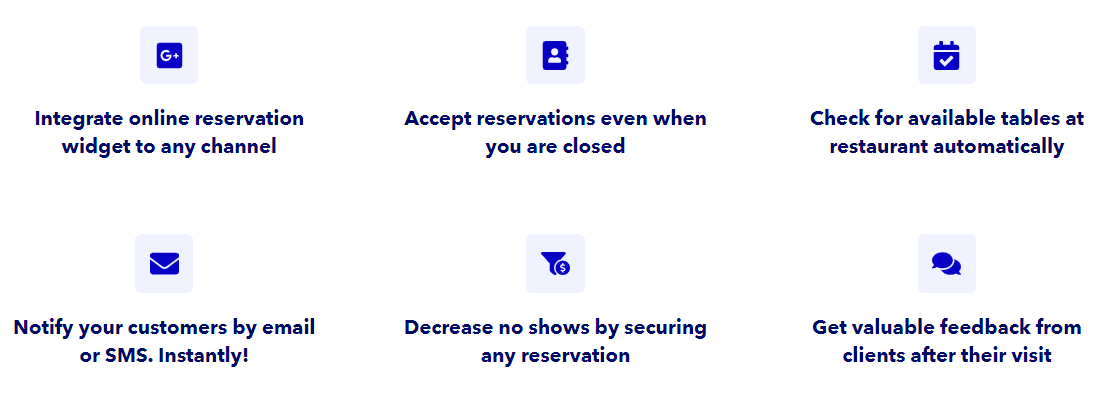
Source: Tablein
Tablein shines with its clear interface, and a calendar view where you can see all your data and reservations at a glance.
The platform is very intuitive and doesn’t require a steep learning curve, which makes it great for less technical restaurant owners who just want a simple solution to fill their empty tables and automate sales.
So, if you want to find a way to have more filled tables without too much time spent on clicking around the software, Tablein is a great option for you.
Tablein is straightforward and intuitive for both guests and restaurant owners.
After you set up your preferences such as floor plan and table reservation times, you’re all set, and can enjoy the benefits of increased sales.
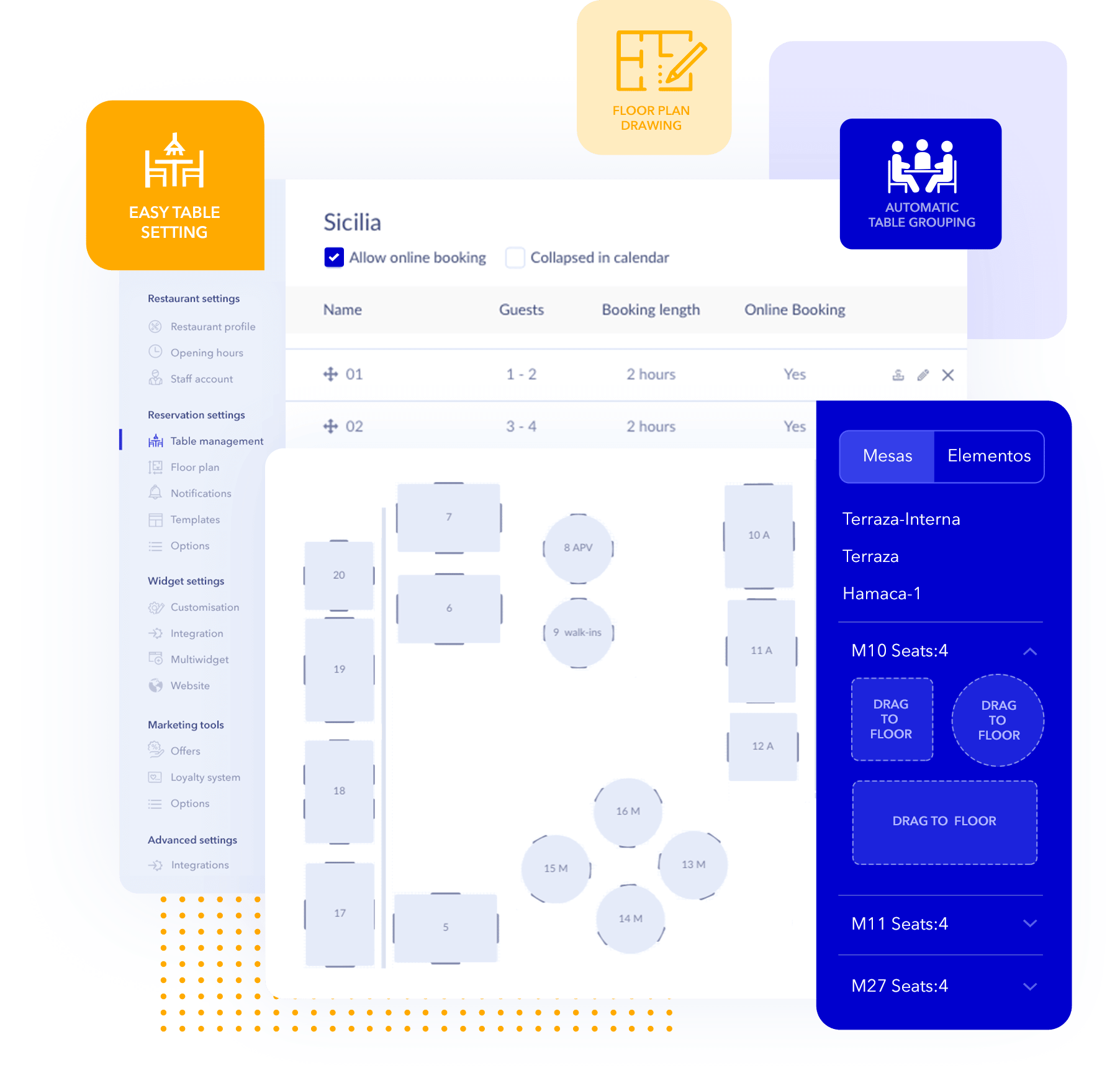
Source: Tablein
Let’s summarize the pros and cons of Tablein.
Pros:
- User-friendly interface
- See everything from one central place
- Affordable pricing
- Floor plan drawing and organization
- Individual table turnovers to eliminate empty tables
- Integration for social media bookings
- Guest communication and reminders for less no-shows
- Guest feedback and ratings for more restaurant exposure
- Waitlist management
- Reporting and analytics
- Website creation option
- Payment processing for reservation deposits
Cons:
- Has a more focused set of features compared to some competitors
- Might not be suitable for very large establishments that want to integrate whole restaurant management in one tool
Finally, let’s talk about how much all this will cost you.
In terms of pricing, we offer two pricing tiers and a 14-day free trial where you can try out all of the product features.

Source: Tablein
The standard package is best suited for smaller restaurants that get up to 200 reservations per month.
Those operating larger establishments should try out the premium option that has no reservation limitations.
So, give Tablein a go and see how it works for you.
Eat App
Eat App is a comprehensive restaurant reservation system that offers a variety of features, including online reservations, table and waitlist management, along with various reports and analytics.
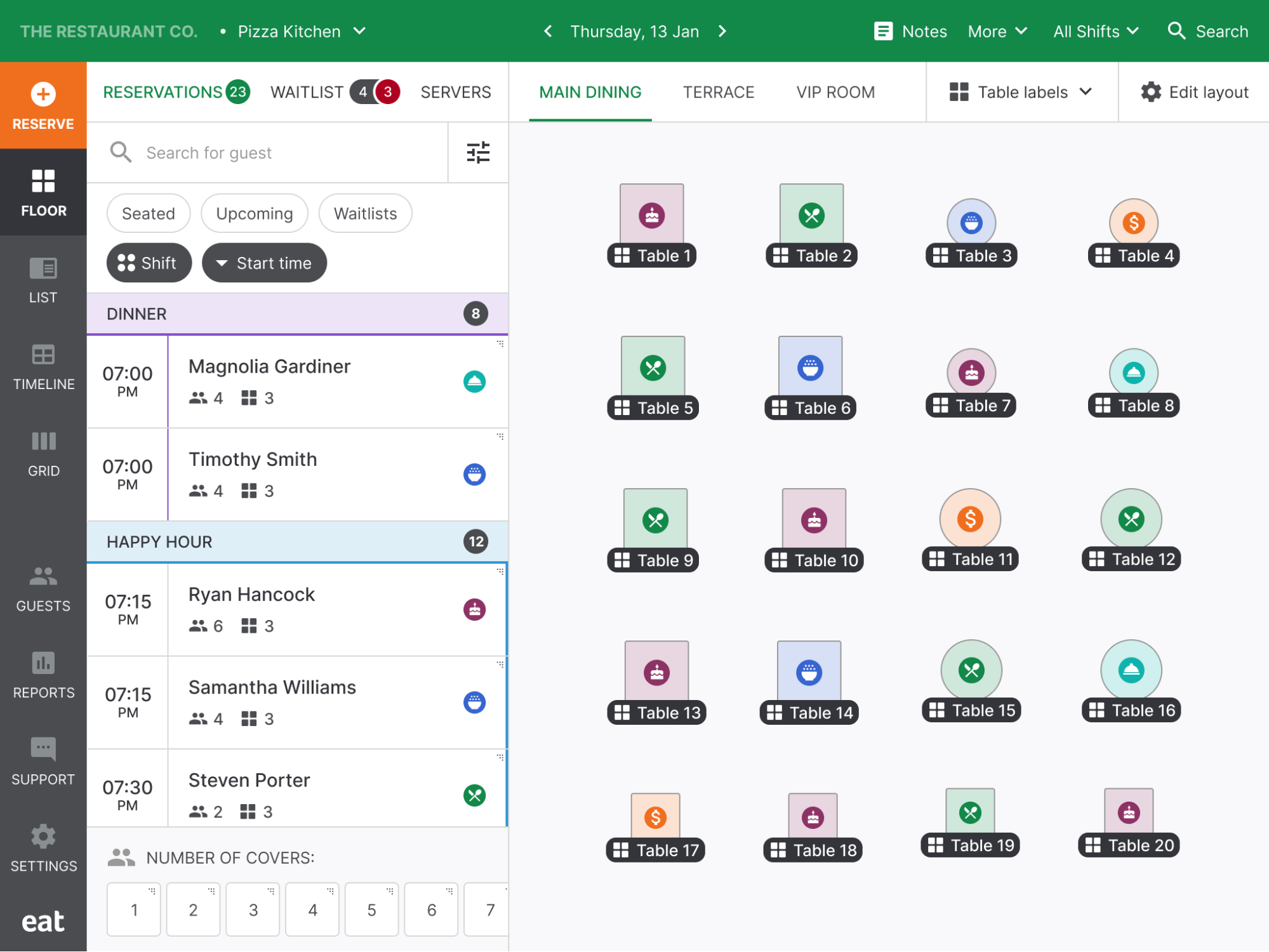
Source: Software Advice
The image above showcases Eat App's table management screen. As you can see, a plethora of features is available, allowing for effective reservation management.
However, the Eat App is a bit more complex system to get accustomed to.
Compared to Tablein, it has a steeper learning curve and not that polished or intuitive user interface.
Pros:
- Versatile and feature-rich
- Various integrations
- Marketing options
- Contactless dining experience
- Shift pacing
Cons:
- Pricing is higher than that of the competitors
- Add-on fees can mount up
- Can be overwhelming to use
- Most features unlock at the highest price tier
Eat App can impress with its versatility and rich features, but the trade-off is a steep price and a more difficult learning curve to utilize fully.
This software offers three different pricing tiers and a free option with limited features.

Source: Eat App
As you can see, Eat App is a bit more pricey, and the full extent of its functionalities is unlocked in the Pro tier, but if you want to make the investment, this app is worth considering.
Eveve
Eveve is an advanced piece of software that uses its in-house restaurant reservation system, TELOS, to provide restaurateurs with powerful tools to help them manage their bookings and streamline their operations.
This tool offers many features, some of which are listed below:

Source: Eveve
Now let’s consider its pros and cons.
Pros:
- Real-time reservations
- Customizable features
- Detailed analytics
- EPOS integration
Cons:
- No SMS options
- Lack of marketing solutions
- Somewhat outdated interface
Eveve boasts many cutting-edge features, but its user interface, shown below, might seem a bit dated.
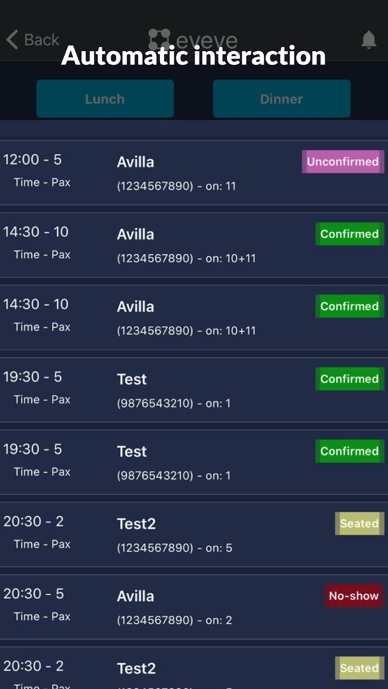
Source: GooglePlay
Furthermore, the lack of SMS communication with guests is a big disadvantage that can lose you some reservations.
Eveve's pricing information is not readily available on their website, but it is known that they do not charge fees per cover, and instead have a licensing fee for their TELOS system.
You can contact their representatives for further details.
Overall, this software is most suitable for larger businesses that are likely to benefit from Eveve’s advanced technology and capabilities.
GloriaFood
Moving forward, let’s introduce the free restaurant reservation software, GloriaFood.
GloriaFood is an effective tool that centralizes pick-up, delivery, and dine-in orders, offering a platform that simplifies accepting orders and reservations.
Through their booking widgets that you can put on your website or social media, diners can effortlessly book a table at your establishment and even pre-order their meal.
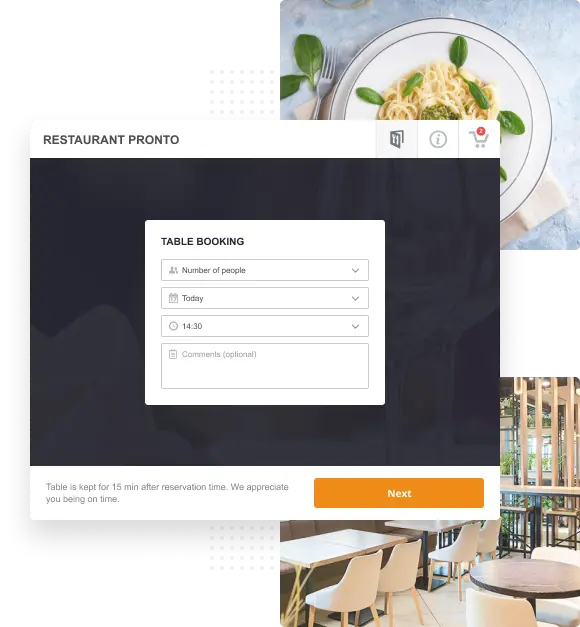
Source: GloriaFood
Here’s a brief overview of its advantages and disadvantages.
Pros:
- Easy-to-use interface
- Online ordering capabilities
- In-built marketing tools
- A robust set of free features
Cons:
- Limited advanced features
- No SMS messaging option
- No visual table management
GloriaFood shines with the fact that the majority of its features are entirely free, with no restrictions or hidden charges.
However, a limited number of paid features are offered, as illustrated below.
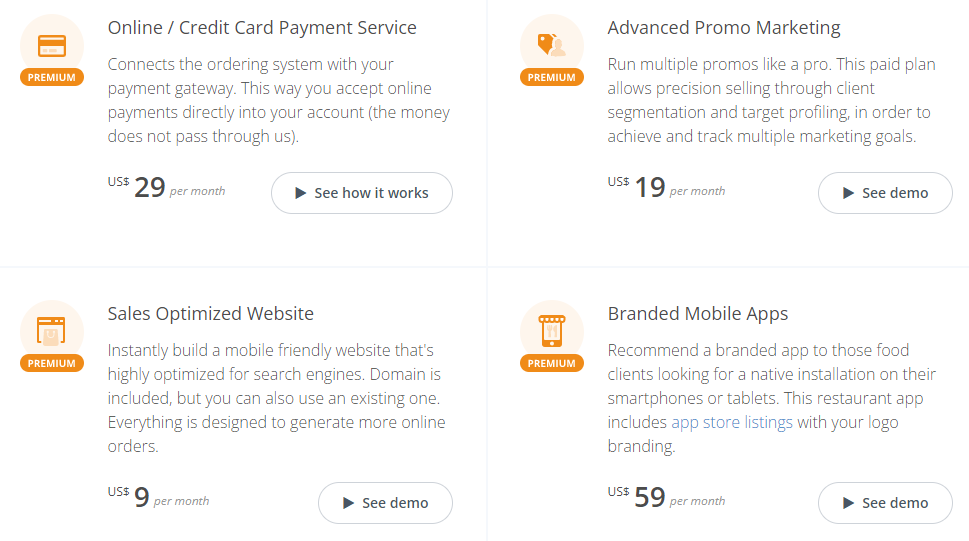
Source: GloriaFood
Even with these features, GloriaFood may still need more advanced capabilities necessary for medium-sized or large restaurants.
But, if you’re a small restaurant looking for a cost-effective solution, this tool can be a great fit.
Hostme
The next tool is an effective software solution for reservations, table management, and handling online orders.
Hostme aims to be a well-rounded restaurant solution, striving for efficiency and simplicity while offering features such as collecting deposits or cancellation fees from guests to lower the chance of costly no-shows.
Its interface is clean and simple, as you can see from the table management screen shown below.
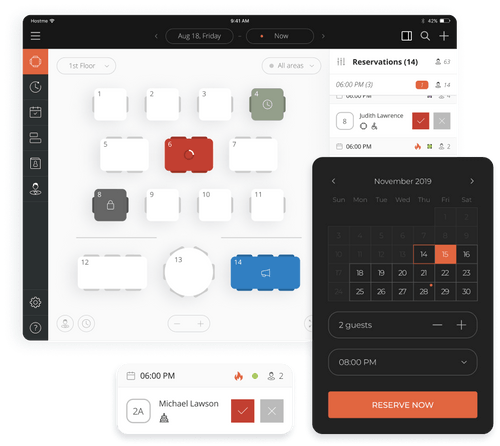
Source: Hostme
Here are the pros and cons of that solution.
Pros:
- Simple interface
- Comprehensive features
- Guest data protection
- Server rotation and management
- Online ordering support
- Event management
Cons:
- Lack of options for attracting new customers
- No options for guest communication
- Limited POS integration options
- Pricing may be a barrier for small restaurants
Let’s take a look at the pricing options available.

Source: Hostme
Hostme has three pricing options offered.
To get the most out of the software, you can get the Mezzo tier, which offers unlimited reservations, while the Grande tier also provides POS integrations and custom branding options.
If these options look good to you, give Hostme a try.
OpenTable
Up next, we present OpenTable, a highly popular tool designed for restaurants, bars, hotels, and similar establishments.
With a vast set of features, this powerful tool offers a comprehensive table and reservation management system, as shown in the screenshot below.
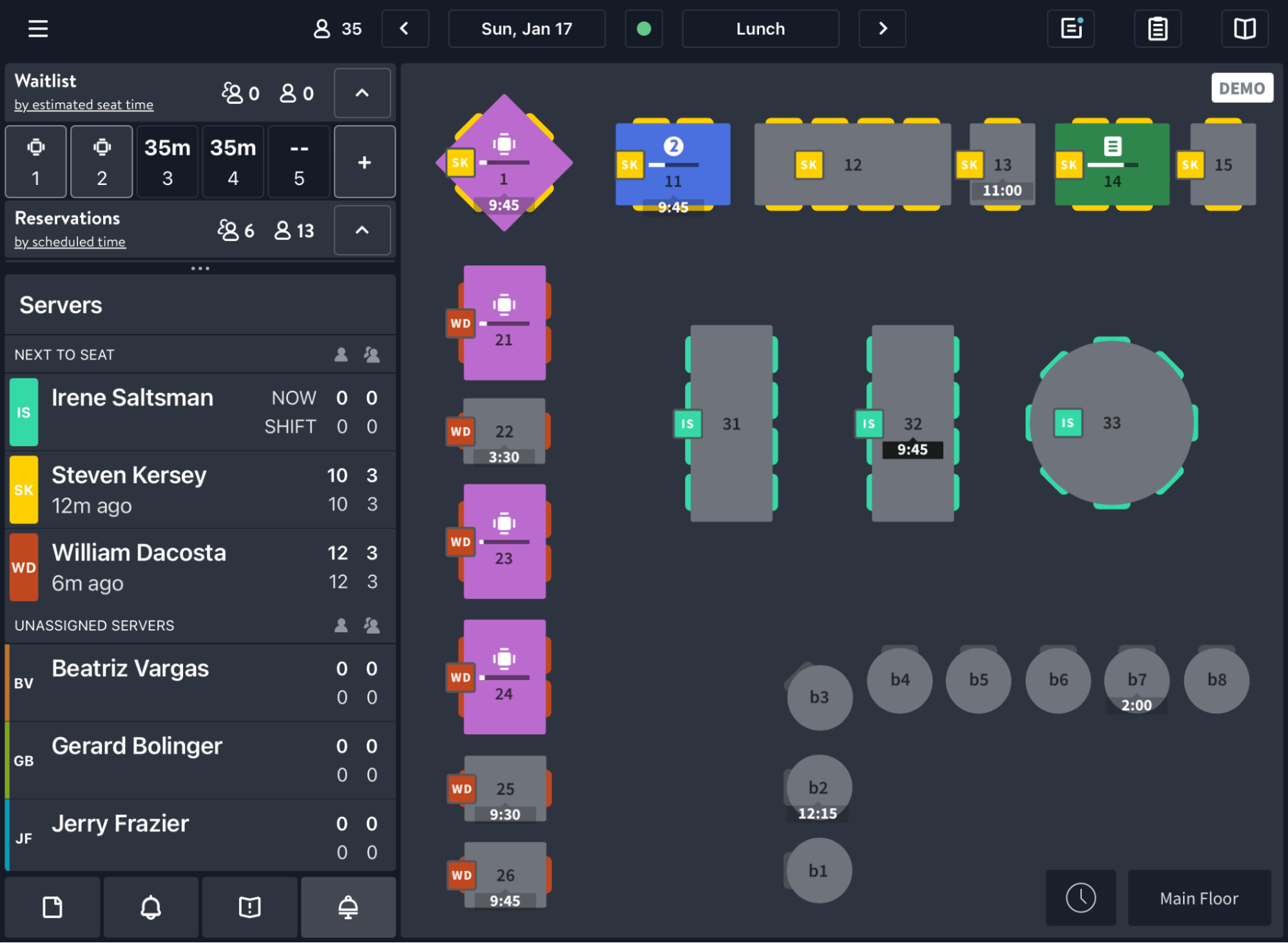
Source: OpenTable
Its other key features include marketing solutions, CRM features, POS integrations, booking and delivery services partnerships, and options to help a restaurant reach a broad audience through its platform.
Pros:
- Access to a vast diner network because of the restaurant marketplace
- Marketing and reputation management options
- Detailed reports and insights
- Online ordering
- Team performance measuring
Cons:
- Can be very expensive
- The basic plan lacks POS integration
- Not much languages supported
- UX could be better
As the pricing goes, OpenTable is one of the most costly options in this article.
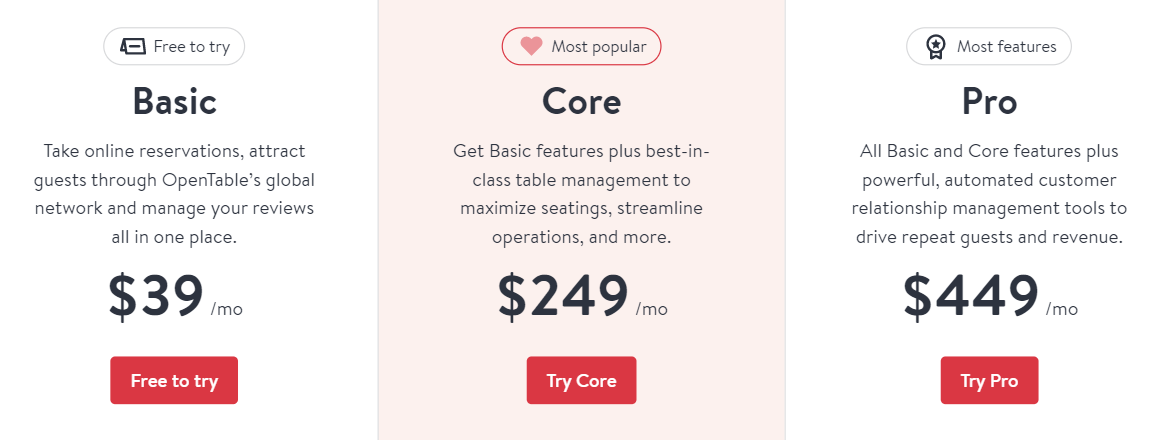
Source: OpenTable
On top of the monthly subscription costs shown above, OpenTable charges a $1 fee for each cover.
So, if someone finds your restaurant through the app and wants to book a table for four, that’s a $4 fee.
Smaller establishments might find these fees too high, but for a high-volume restaurant looking for a competitive edge, OpenTable might be the right choice.
ResDiary
Number eight on our list is ResDiary. This tool has some unique features but also the basic functionalities needed by restaurants.
Regarding reservations, this tool presents potential diners with a simple process for booking a table, illustrated below.
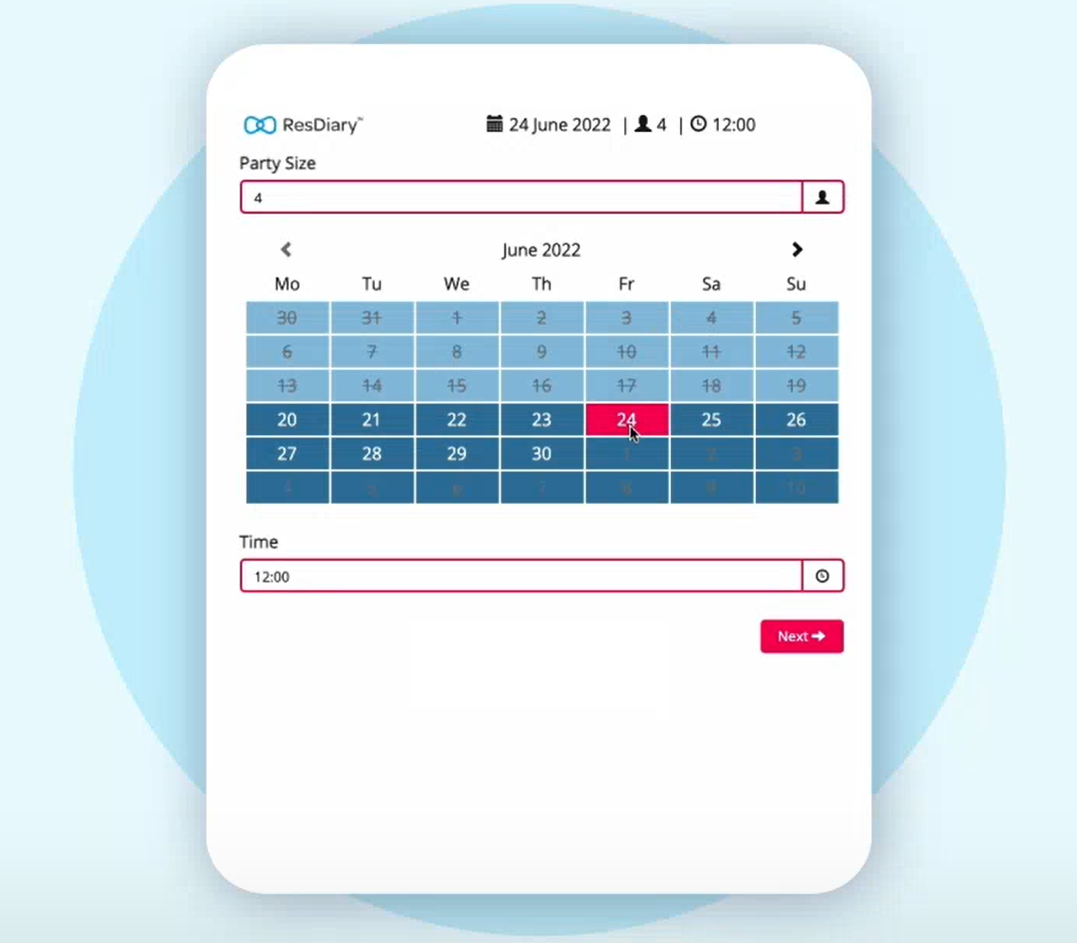
Source: ResDiary
But this feature is just one of many that are offered, including event management, pre-orders, and guest loyalty options like gift vouchers and a points-based loyalty program integrated into the software.
Let’s sum up its pros and cons.
Pros:
- No commissions on bookings
- Easy access to the software on any device
- Over 60 integrations with other tools
- Yield management
- Resphone for an automated telephone service
- Dishcult for restaurant recommendations to diners
Cons:
- No features for no-show prevention or charging prepayments
- Limited to Stripe for payment processing
- The pricing model may not work for everyone
- Not so polished user interface
When it comes to pricing, ResDiary has a unique model that adjusts the price of the second price tier according to the number of reservations you expect to have each month.
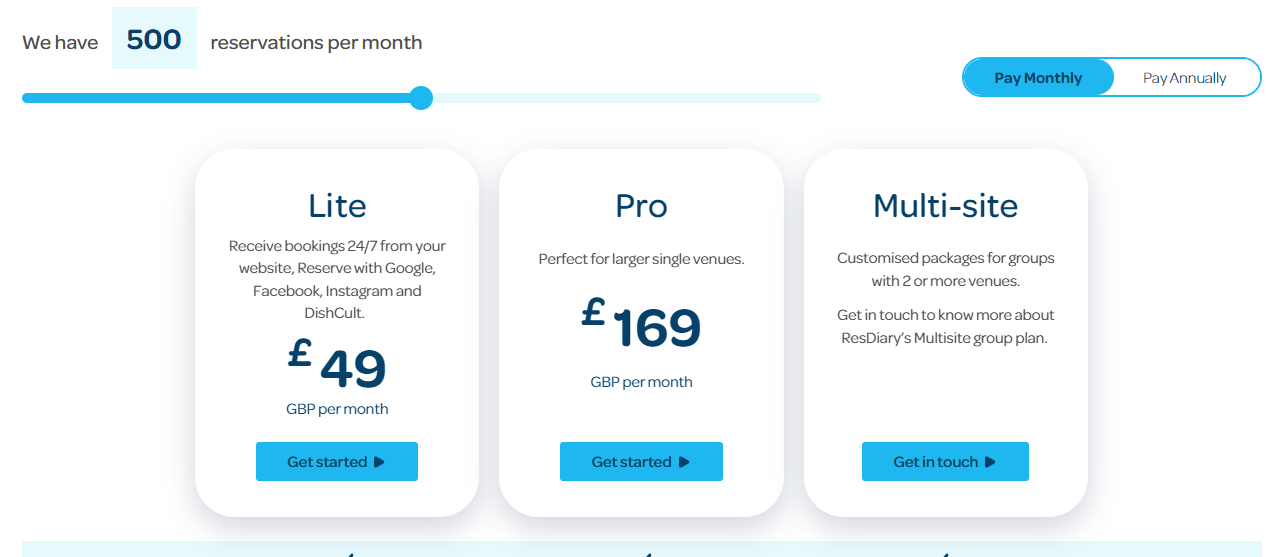
Source: ResDiary
On the other hand, the Lite tier has a fixed price, but the features you get in return are minimal, consisting of the booking feature and a limited number of integrations.
Consider the versatile options of ResDiary and decide if this tool is the right one for you.
ResyOS
Next, we have ResyOS, a highly adaptable restaurant reservation system that delivers a comprehensive suite of features designed to support and enhance the dining experience before, during, and after service.
This versatile platform caters to the diverse needs of restaurants, offering highly customizable options for table and reservation management, like the table and floor plan feature illustrated in the next image.
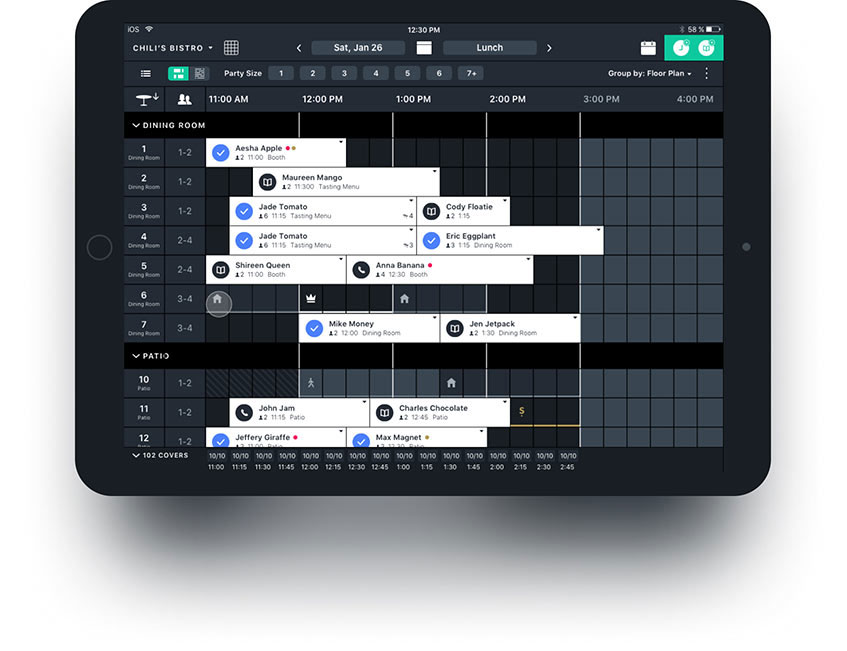
Source: Resy
Acquired by American Express in 2019, ResyOS connects your restaurant to a network of Amex cardholders, enticing them to visit your establishment through various offers, marketing programs, and exclusive benefits.
These are its advantages and disadvantages.
Pros:
- Extensive customization options
- Covers all the basics for reservation management
- Auto reminders
- Various integrations
- Pre-pay options
Cons:
- Expensive monthly plans.
- The basic plan lacks customization options.
- Can be overwhelming due to its extensive features.
ResyOS’s pricing is also among the least accessible of the tools we’ve covered in this article.

Source: Resy
The price comes with a myriad of features that, for large establishments with a high volume of guests, might make ResyOS the perfect fit.
TableAgent
TableAgent is a completely free restaurant reservation system that focuses on helping establishments save money while streamlining their reservation process.
This tool has a list-based way of managing reservations that resembles a digital version of a traditional reservation record book.
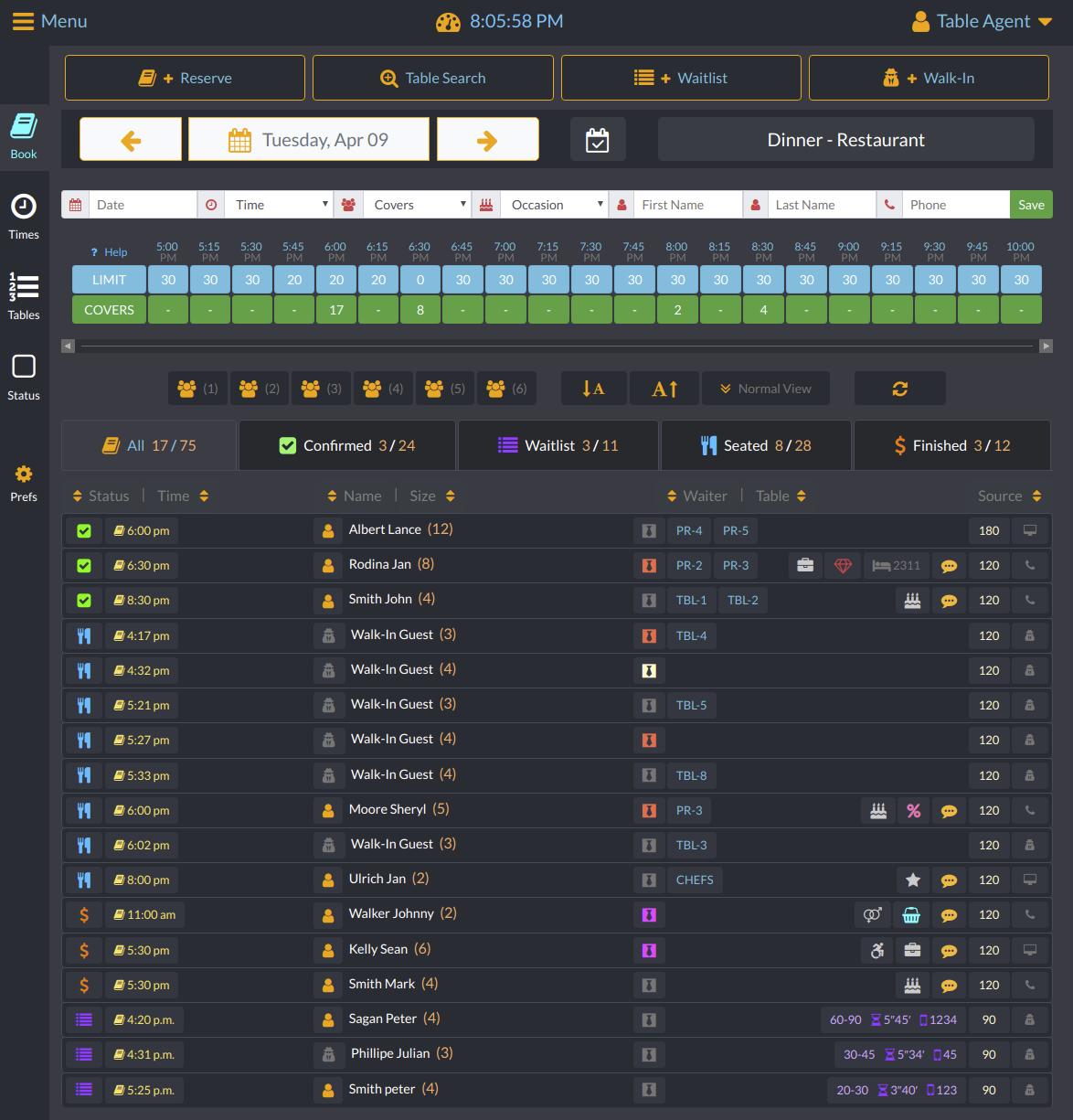
Source: TableAgent
As you can see, this approach to handling reservations may take some work to navigate. Still, if you go with this software, you get several advantages.
Let’s take a look at them first, and then examine the disadvantages.
Pros:
- Completely free
- Online payments accepted
- Suitable for small establishments
- Cloud-based
Cons:
- Limited features compared to competitors
- Lacks a marketplace for showcasing restaurants
- Limited customer support options
- May not suffice for larger restaurants
- Poor user experience
TableAgent can be an ideal choice for restaurant owners seeking a basic reservation management system for no cost. The features offered are listed out below.
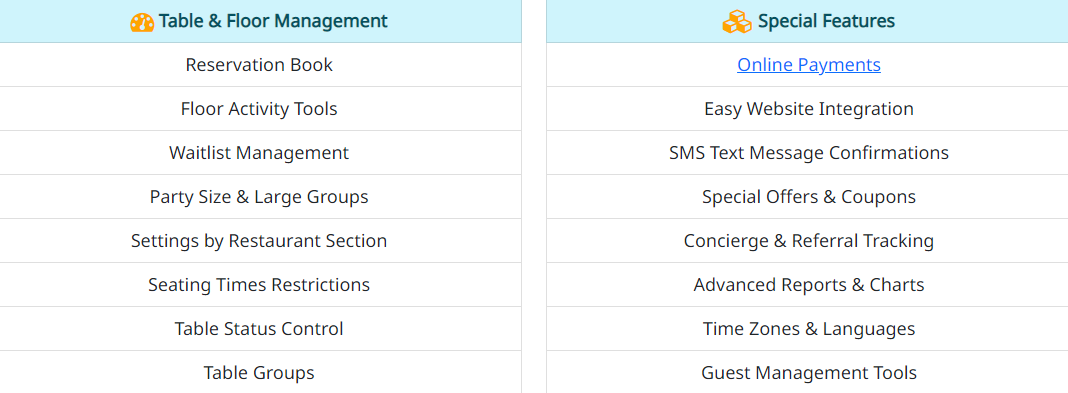
Source: TableAgent
However, with a lack of additional features offered by other reservation software, you might need to explore alternatives to meet your needs fully.
Still, you’ve got nothing to lose by trying out this free software for yourself.
TheFork
Coming up next is a widely used platform, TheFork.
At its core, this platform includes a straightforward reservation system, with a simple way for guests to book a table, pictured below.
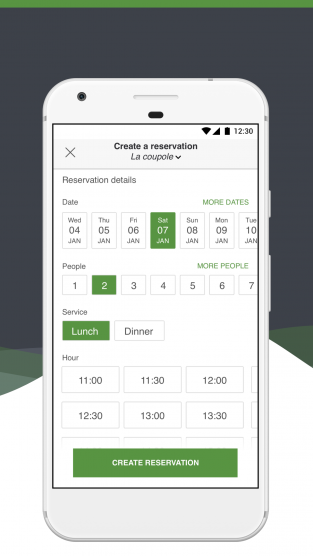
Source: TheFork
However, this Tripadvisor subsidiary also offers ways to increase your restaurant’s visibility and connect you to a vast network of potential customers, including both locals and travelers.
Here are its benefits and drawbacks.
Pros:
- Provides access to a large network of potential customers as a Tripadvisor subsidiary
- Reduces no-show rates with various tools
- Optimizes table management
- Offers customer loyalty tools
- Free custom page for the restaurant
Cons:
- No intermediate pricing options in some countries
- Some features may not be available in specific locations
- Fees are based on a per-cover rate
The price options for TheFork vary by country, so you should check the pricing plans for your country on their site.
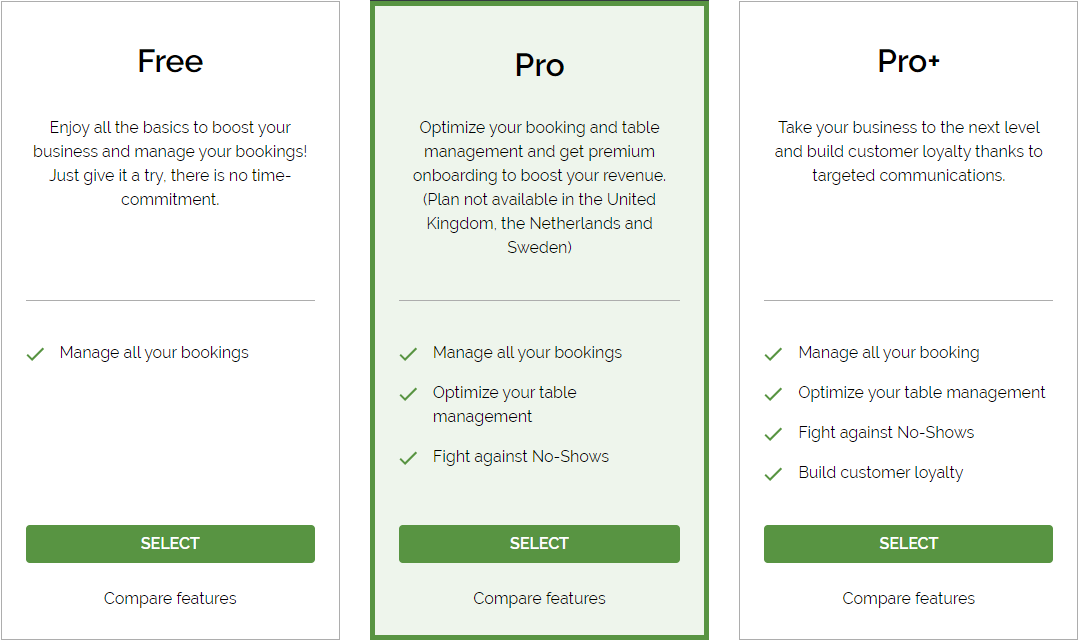
Source: TheFork
On top of the per-month fees, TheFork has an additional pay-per-use fee for every seat covered, so you should take this into account.
With over 50,000 restaurants from 22 countries worldwide using this tool, you might at least consider it for your restaurant.
Tock
Tock is a cloud-based reservation system offered by the website-building platform Squarespace.
Developed initially as a way to prevent no-shows with a deposit and prepayment system, Tock gradually became a complete reservation management software solution with a range of features, listed in the following image.

Source: Tock
Tock is not a classic reservation system, but more of a sales engine. It offers things like merchandise management etc.
Let’s have a look at them.
Pros:
- Optimized table management to maximize profitability
- Many high-profile clients and partners
- Marketing and customer relationship tools
- Event management
- Delivery features
- Guest surveys
- Marketplace
Cons:
- Requires access and management on your hardware
- Less user-friendly compared to the alternatives
- Pricing can be expensive for some businesses
- Smaller diner network compared to competitors
Tock’s pricing options are a bit on the higher end, with the Plus package requiring a 2% fee on all prepaid reservations, but you get access to all features immediately.
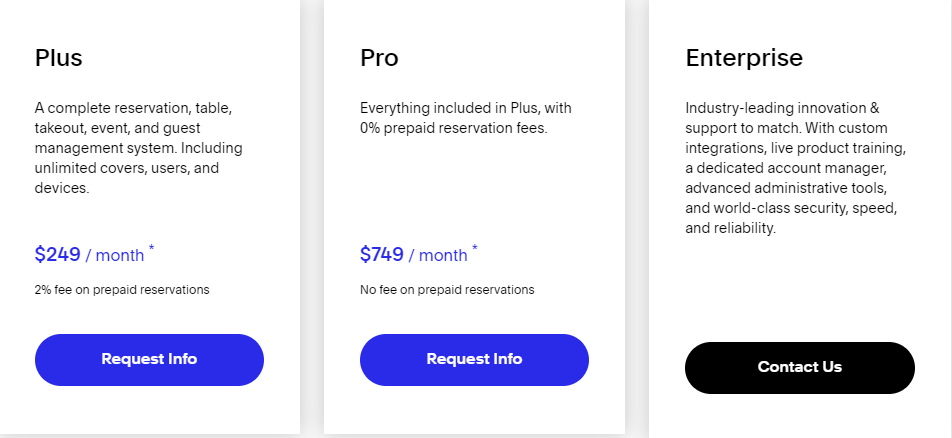
Source: Tock
The Pro package has all the same features without the 2% fee, while the Enterprise package targets customers who want premium tools and support.
If you want a reservation system tailored for high-end dining establishments that simplifies prepaid bookings, consider looking at Tock.
Wisely
Finally, the last on our list is Wisely, a sophisticated tool owned by Olo that allows you to create excellent guest dining experiences.
This aim is accomplished by offering a straightforward way for guests to book a table or join your waitlist from a clear and simple booking interface through your website or social media platforms.
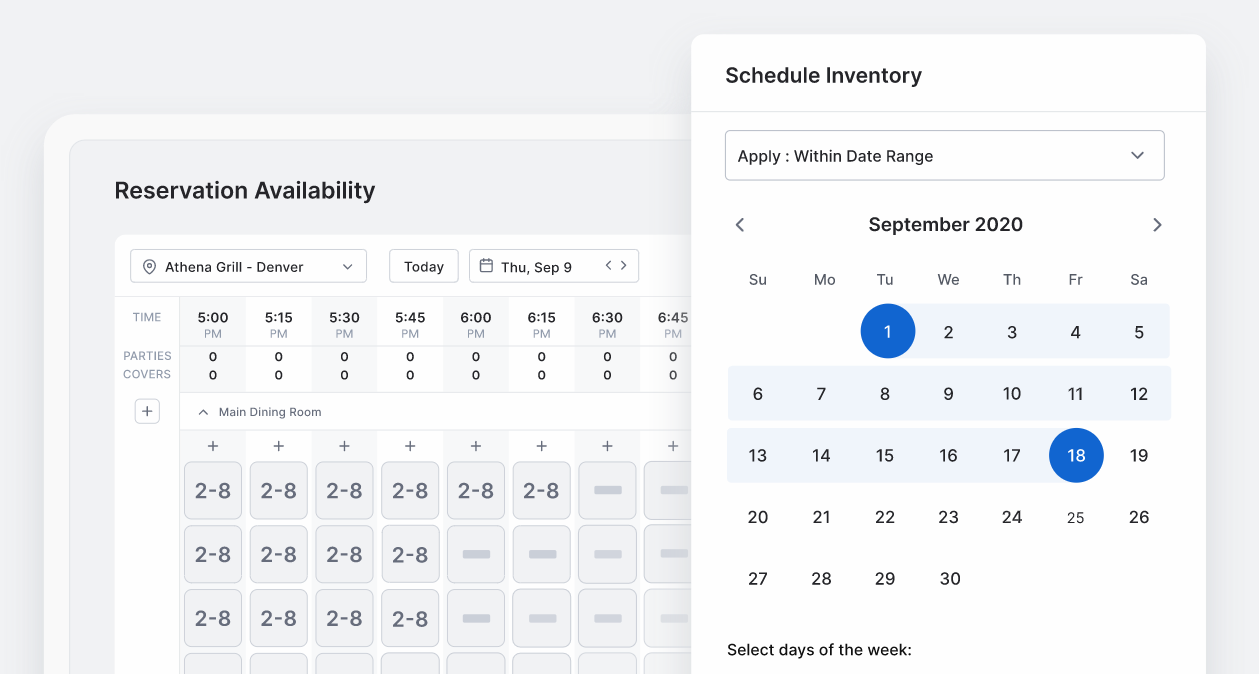
Source: Wisely
Additionally, Wisely offers marketing tools, reports and analytics, pick-up order options, and prepayments to help optimize your restaurant’s performance.
Pros:
- Integrates with popular POS systems
- Powerful email and text messaging marketing tools
- Advanced table management software and analytics
- Integrated with Olo delivery services
Cons:
- No marketplace for advertising to new customers
- May take time to figure out all functionalities
- No free trial offered
Wisely offers many premium features to ensure your diners have a great time at your restaurant.

Source: Wisely
If you are interested in this tool, you’ll have to contact Olo’s sales team and request the pricing information.
Overall, Wisely is an excellent and versatile tool you should seriously consider for your restaurant operations.
Conclusion
In this article, we provided an overview of twelve of the most effective restaurant reservation software, thoroughly exploring their advantages and disadvantages.
Our hope is that the insights we have given you into the various platforms and their features will equip you with the knowledge to identify the perfect tool for your establishment.
With the right software, you can efficiently manage reservations, enhance customer satisfaction, and ultimately boost your bottom line.
Embrace the power of a top-notch reservation system and watch your restaurant flourish like never before.
Happy booking!
Get a 30-day Exclusive Trial
As a Tablein blog reader, you’re eligible for an exclusive 30-day free trial to experience our simple reservation solution for your restaurant.
Enter your business email, and we’ll send you all the steps needed to create your account.
Share this
You may also like

Top 7 Features a Restaurant Reservation Software Needs to Have

8 Best Restaurant Reservation Systems
